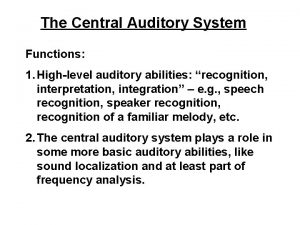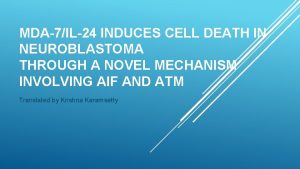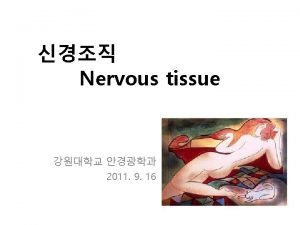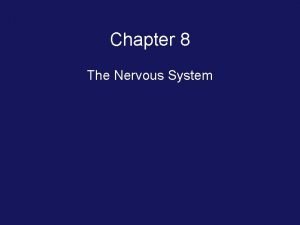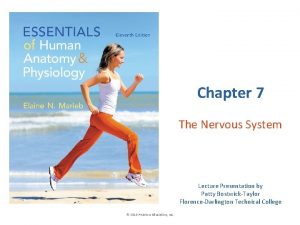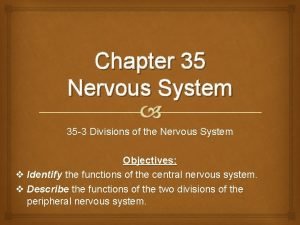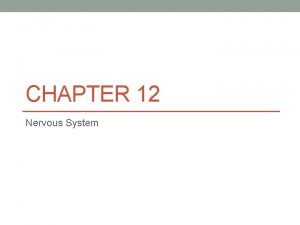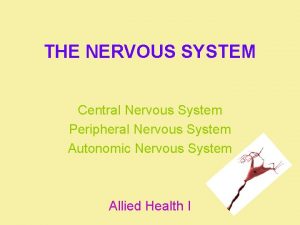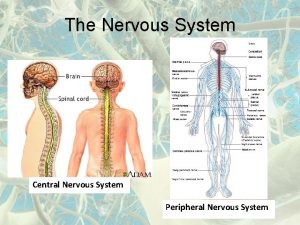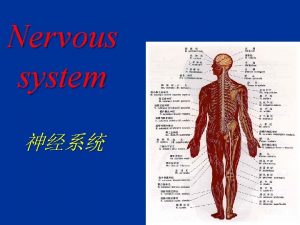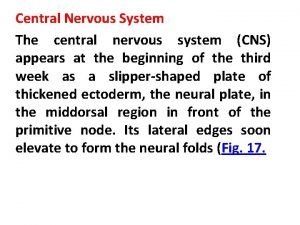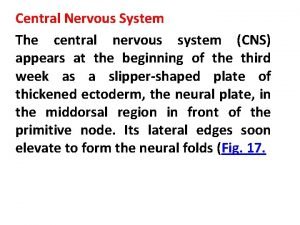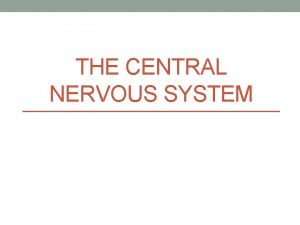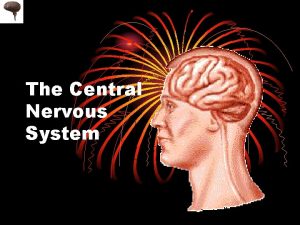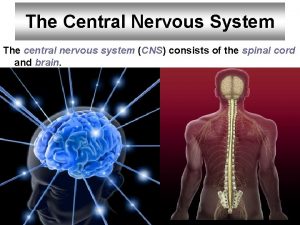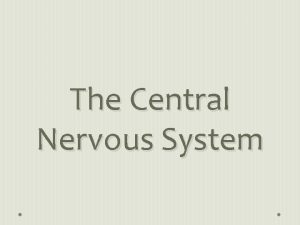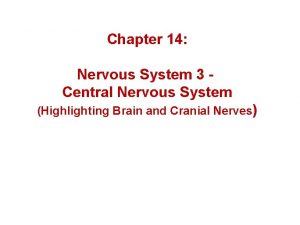Chapter 21 The Nervous System Nervous System Central








































- Slides: 40

Chapter 21 The Nervous System

Nervous System • Central nervous system (CNS) consists of the: – Surrounded by protective membranes called: • Dura: • Arachnoid: – Subarachnoid space: » Contains: • Pia: – Adheres to the surface of the:

Nervous System • Brain and spinal cord are encased in protective bony structures – Cranium: – Vertebral column: • CSF acts as a cushion to protect the brain

Brain • Divided into: – Cerebrum, cerebellum, brain stem • Has four cavities called ventricles – Contain CSF

Blood Supply of the Brain • Arterial blood supply – Large vessels enter base of skull – Vessels join to form arterial circle at base of brain • Branches of the circle supply all parts of the brain • Venous blood – From brain into large venous sinuses in dura – Sinuses eventually drain into jugular veins

Blood Supply of the Brain Arterial Blood Supply Venous Blood Return

Nervous System • Tissues of brain and spinal cord are composed of: – Supporting cells called: – Nerve cells called: • Neurons contain long processes called nerve fibers which conduct nerve impulses • Some nerve fibers are surrounded myelin which helps insulate and increase speed of nerve impulses – Myelinated nerve fibers make up white matter of brain & spinal cord – Gray matter is made up of neurons, neuroglia, & unmyeliated nerve fibers

Nervous System • Sensory or afferent nerves transmit impulses: • Motor or efferent nerves transmit impulses: • Cerebral cortex receives sensory input & initiates voluntary motor activity – Spinal cord relays information between parts of the body and the brain – Left side of brain controls right side of body and vice-versa

Muscle Paralysis • A muscle that is: • Two types: – Flaccid paralysis – Spastic paralysis

Cerebral Injury • A severe blow to the head may cause brain injury • Injury to the brain may cause loss of consciousness & various neurological disturbances • Injured region of brain may swell but cranial cavity is rigid and doesn’t give – Swelling is restricted & compresses the swollen brain, leading to: • Adversely affects:

Skull x-ray illustrating large skull fracture (arrows) associated with extensive injury to underlying brain. Fig. 21 -2

Mechanism of injury to frontal and temporal poles of brain caused by blow to back of head.

Cerebral Injury • Large blood vessels over surface of brain may be torn by force of injury – Blood may accumulate in different locations depending on which vessels are damaged • Epidural hemorrhage: – Between the: • Subdural hemorrhage – Between the: • Subarachnoid hemorrhage: – Between the: – Epidural & subdural hematoma may compress the brain & impair function

Neural Tube Defects • Failure of the neural tube to close properly • Follow a multifactoral pattern of inheritance – Means many causes – Factors are usually both genetic & environmental • Deficiency of folic acid in the first trimester is an important cause

Neural Tube Defects • Spina bifida – Malformation of the caudal neural tube and related vertebral arches • Name means split spine in reference to: – Diagnosis: maternal blood test and amniocentesis looking for elevated levels of: • Diffuses from fetal blood into amnionic fluid & mothers blood through open neural tube defect

Neural Tube Defects • Spina bifida – Types: • Spina bifida occulta – Failure of the vertebral arches in the lower lumbar region to fuse – Symptoms produced: • Spina bifida cystica with meningocele – Saclike protrusion consisting only of: • Spina bifida cystica with meningomyelocele – Saclike protrusion consisting of: – There is often a severe neurological deficit below the level of the sac

Various types of spina bifida.

Large thoracic meningomyelocele covered by thin membrane Fig. 21 -6

Stroke • Also called cerebrovascular accident or CVA • Is the name for any injury to brain tissue from: • 3 types of stroke – Cerebral thrombosis: most common • thrombosis of cerebral artery or a major artery supplying the brain which is narrowed by: – Cerebral embolus: occurs less frequently • blockage of cerebral artery by fragment of blood clot from: – Cerebral hemorrhage: most serious type of stroke • usually from rupture of a cerebral artery in person with:

Infarct, right cerebral hemisphere from thrombosis of middle cerebral artery Fig. 21 -10

Coronal section of brain illustrating large cerebral hemorrhage that has compressed and displaced the cerebral ventricles. Fig. 21 -14

Stroke • Diagnosis – Cerebral angiogram • Radiopaque die is injected into the carotid & vertebral arteries • The dye is followed using x-rays in order to visualize blood flow through vessels – Carotid endarterectomy • Surgical removal of arteriosclerotic plaque that may occlude the carotid arteries & impede cerebral blood flow • Performed by making an incision in the carotid artery and removing the plaque

Stroke • Manifestations – Clinical effects of stroke depend on the location & severity of the brain damage – Extensive damage may cause partial paralysis by disrupting nerve fibers – Hemiplegia: a stroke involving one cerebral hemisphere often leads to weakness on the opposite side

Transient Ischemic Attack • Often referred to as a TIA • Brief episodes of neurologic dysfunction such as: • Episodes tend to last for: – After the episode the symptoms: • Usually caused by an embolization of material from plaque in carotid artery – Obstructs: • One-third of patients eventually suffer major stroke • Treatment: endarterectomy or medical therapy

Transient Ischemic Attack

Cerebral Aneurysm • Congenital aneurysm – – – Congenital weakness in arterial wall allows lining to protrude Weakness is congenital but aneurysm develops in adult life Rupture causes subarachnoid hemorrhage People with hypertension are more prone Treatment: aneurysm occluded surgically

Dissection of vessels from the brain of a person with large congenital cerebral aneurysm. Fig 21 -16

A cerebral aneurysm (arrow) demonstrated by an angiogram. Fig 21 -18 b

Undersurface of brain, illustrating subarachnoid hemorrhage secondary to ruptured cerebral aneurysm. Fig 21 -17

Infections of the Nervous System • Nervous system can be infected by bacteria, fungi, & viruses • Meningitis is an infection affecting the: • Encephalitis is an infection of: • Meningoencephalitis is an infection of both the: • Symptoms of CNS infection include fever, headache, stiff neck, & alteration of consciousness & neurologic symptoms if brain involved • Spinal tap is performed to diagnose

Meningitis from Bacteria • Most cases of bacterial meningitis are caused by two organisms 1. 2. • A third organism was a common cause in children but is routinely immunized against 3.

Meningitis from Bacteria • Meningococcus (Neisseria meningiditis) – Occurs primarily in: – Often becomes epidemic where people live in close quarters such as: – If a person is infected, all people with close contact to this person have to be treated with antibiotics • Pneumococcus (Streptococcus pneumoniae) – Occurs sporadically in: – Not transmitted from person to person so close contacts don’t have to be treated

Bacterial meningitis, illustrating purulent exudate in the meninges Fig. 21 -19

Viral Infections • Many viruses may affect the nervous system including: measles, mumps, herpes simplex virus, intestinal and respiratory viruses, cytomegalovirus, poliomyelitis virus, & arborviruses • Can cause meningitis & encephalitis • Encephalitis can be very serious and unfortunately there is no treatment for viral infection

Alzheimer Disease • Is a chronic progressive disease – Characterized by progressive failure of recent memory & difficulties in thinking, reasoning, & judgement – Often associated with emotional disturbances such as: • Brain shows loss of neurons with atrophy of the cerebral cortex – Neurofibrillary tangles: – Neurotic plaques: • No specific treatment; but some drugs may temporarily improve cerebral function

Multiple Sclerosis • Chronic disease characterized by randomly distributed degeneration of the myelin sheaths of nerves found in the brain & spinal cord • Probably an autoimmune disease in generally predisposed individual – Most likely initiated by a viral infection in a genetically predisposed person • Neurologic symptoms depend on location of plaques – Demyelination disrupts nerve impulses – Remission of symptoms occur after an attack • MRI demonstrates plaques in CNS – No cure

Coronal section of brain illustrating areas of gilial scarring (arrows) adjacent to ventricle in multiple sclerosis. Fig. 21 -22

Multiple sclerosis demonstrated by MRI. Fig. 21 -23

Parkinson Disease • Most cases unknown etiology • Some develop subsequent to viral infection of nervous system or toxic drugs • Manifestations – – Progressive loss of neurons in substantia nigra of midbrain Rigidity of voluntary muscles Tremors of fingers and extremities Decreased dopamine in CNS • Treatment: relieved by L-dopa – Embryonic stem cells may be key to successful treatment; possible to induce stem cells to differentiate into dopamineproducing neurons to treat disease

? ? QUESTIONS? ?
 Neuronal pools
Neuronal pools Fundamentals of the nervous system and nervous tissue
Fundamentals of the nervous system and nervous tissue Fundamentals of the nervous system and nervous tissue
Fundamentals of the nervous system and nervous tissue Nervous system major divisions
Nervous system major divisions Central nervous system amusement park
Central nervous system amusement park The central nervous system
The central nervous system Building vocabulary activity: the central nervous system
Building vocabulary activity: the central nervous system Arthropod nervous system
Arthropod nervous system Central auditory nervous system
Central auditory nervous system Part of nervous system
Part of nervous system Central nervous system for kids
Central nervous system for kids Central nervous sysytem
Central nervous sysytem Chapter 7 the nervous system
Chapter 7 the nervous system Chapter 15 nervous system diseases and disorders
Chapter 15 nervous system diseases and disorders Chapter 8 the nervous system
Chapter 8 the nervous system Chapter 7 the nervous system figure 7-2
Chapter 7 the nervous system figure 7-2 Chapter 35 nervous system
Chapter 35 nervous system Chapter 14 the skeletal muscular and nervous systems
Chapter 14 the skeletal muscular and nervous systems Chapter 12 nervous system
Chapter 12 nervous system Nervous system and digestive system
Nervous system and digestive system Endocrine system vs nervous system
Endocrine system vs nervous system Amino acid-based hormones
Amino acid-based hormones Endocrine system
Endocrine system Hình ảnh bộ gõ cơ thể búng tay
Hình ảnh bộ gõ cơ thể búng tay Lp html
Lp html Bổ thể
Bổ thể Tỉ lệ cơ thể trẻ em
Tỉ lệ cơ thể trẻ em Voi kéo gỗ như thế nào
Voi kéo gỗ như thế nào Chụp tư thế worms-breton
Chụp tư thế worms-breton Chúa yêu trần thế
Chúa yêu trần thế Kể tên các môn thể thao
Kể tên các môn thể thao Thế nào là hệ số cao nhất
Thế nào là hệ số cao nhất Các châu lục và đại dương trên thế giới
Các châu lục và đại dương trên thế giới Công thức tính thế năng
Công thức tính thế năng Trời xanh đây là của chúng ta thể thơ
Trời xanh đây là của chúng ta thể thơ Mật thư anh em như thể tay chân
Mật thư anh em như thể tay chân Làm thế nào để 102-1=99
Làm thế nào để 102-1=99 độ dài liên kết
độ dài liên kết Các châu lục và đại dương trên thế giới
Các châu lục và đại dương trên thế giới Thể thơ truyền thống
Thể thơ truyền thống Quá trình desamine hóa có thể tạo ra
Quá trình desamine hóa có thể tạo ra








